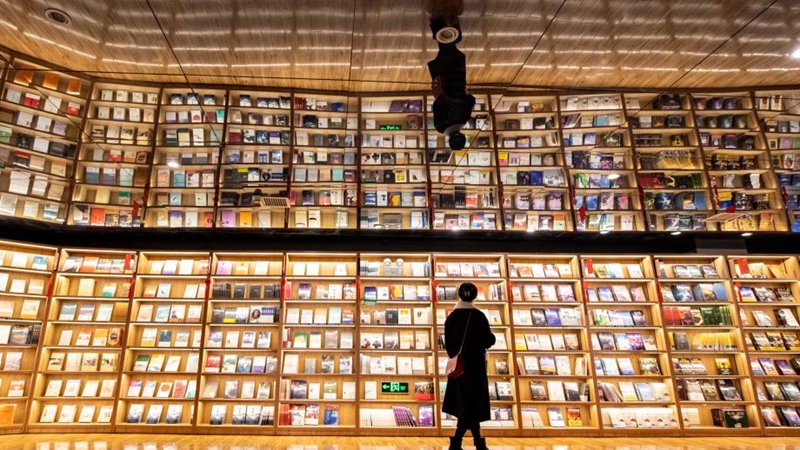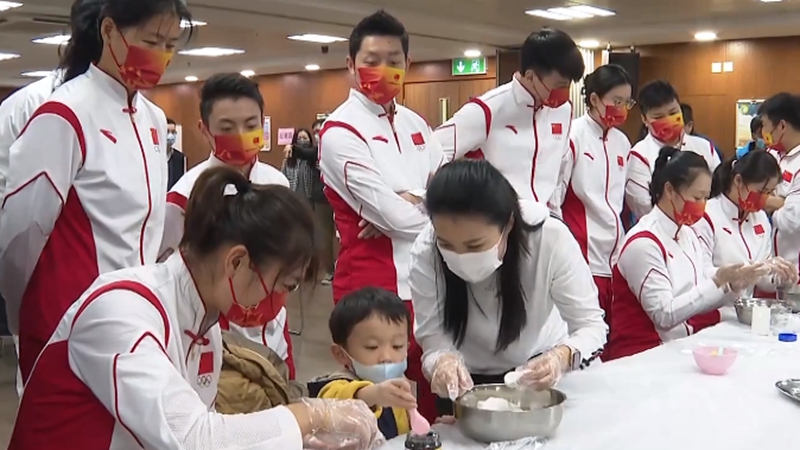
A man wearing a face mask walks in front of a mural dedicated to frontline medical workers fighting against the COVID-19 pandemic in Kuala Lumpur, Malaysia, Jan. 29, 2021. (Photo by Chong Voon Chung/Xinhua)
-- Asia-Pacific walks a tightrope amid pandemic, and many valuable lessons have been learned this year;
-- China has helped many developing countries in Asia-Pacific in their vaccination drives;
-- Multilateralism is essential to the fight against COVID-19.
by Xinhua writer Wu Junyi
HONG KONG, Dec. 24 (Xinhua) -- Just as the world paused for breath following almost two years in the thrall of COVID-19, the more contagious Omicron variant cropped up and plunged the world back into uncertainty.
Asia-Pacific countries are once again forced to tighten restrictions on travel, restrict mass gatherings and impose workplace protocols.
Governments are faced with difficult choices. There are pros and cons on both sides: reimposition of strict controls or continued normalization of society.
Many valuable lessons have been learned in the past two years, with many Asia-Pacific countries scrambling to establish formats of contact-tracing, nucleic acid testing, medical treatment and mass vaccination, in which China has been lending a helping hand with vaccines and medical support to those in need.
As the pandemic heads into a third year, the Asia-Pacific walks a tightrope.

People standing with empty medical oxygen cylinders to get them filled for COVID-19 patients at a plant in Patna, India, April 27, 2021. (Str/Xinhua)
HOPE FOR BEST, PREPARE FOR WORST
Shutdowns and lockdowns were widely imposed across the world this year, and access to vaccines is widely considered a key to economic recovery.
India reported fewer than 10,000 new daily infections in December, compared to over 400,000 new cases with 4,000 new deaths for several days in May, a clear sign of the efficacy of the preventive measures the Indian government has been taking and the success of the ongoing vaccination program.
Japan, with about 78 percent of its population double-vaccinated, remains cautious on Omicron. The country experienced a surge in COVID-19 cases during the Tokyo Olympics and Paralympics, hitting 25,000 daily in August. Since then, there has been a dramatic decline in cases.
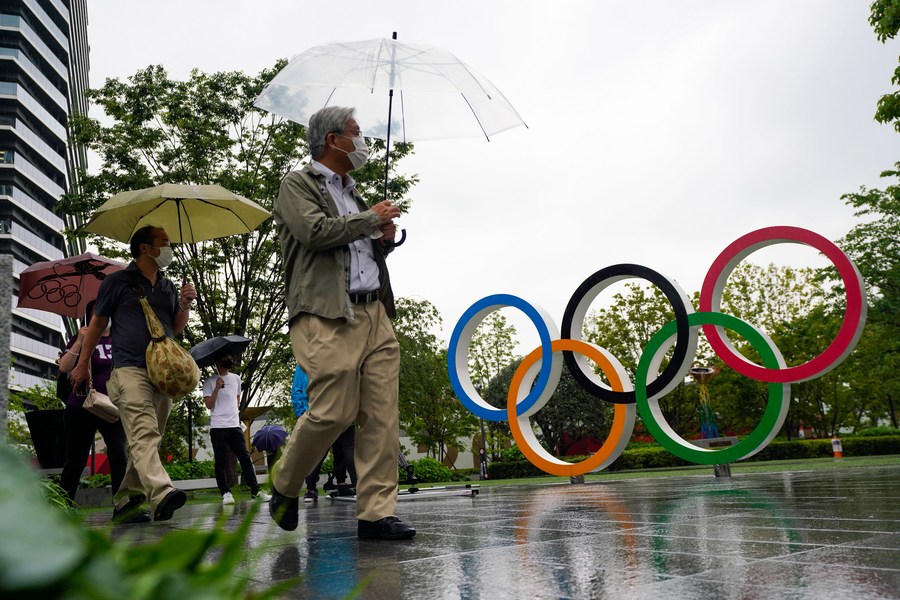
People walk past the Olympic Rings near the new National Stadium in Tokyo, Japan on July 8, 2021. (Photo by Christopher Jue/Xinhua)
Early in December, Japan banned inbound flight bookings, but quickly withdrew the instruction after facing massive criticism. Currently, new entry of foreign nationals is being suspended.
Japan's economy declined an annualized 3.6 percent in the third quarter, worse than its preliminary reading, due to a larger fall in private consumption amid COVID-19, the latest official data showed.
Japanese Prime Minister Fumio Kishida vowed to "prepare for the worst" in dealing with the Omicron variant, while hoping for getting the economy back on track.
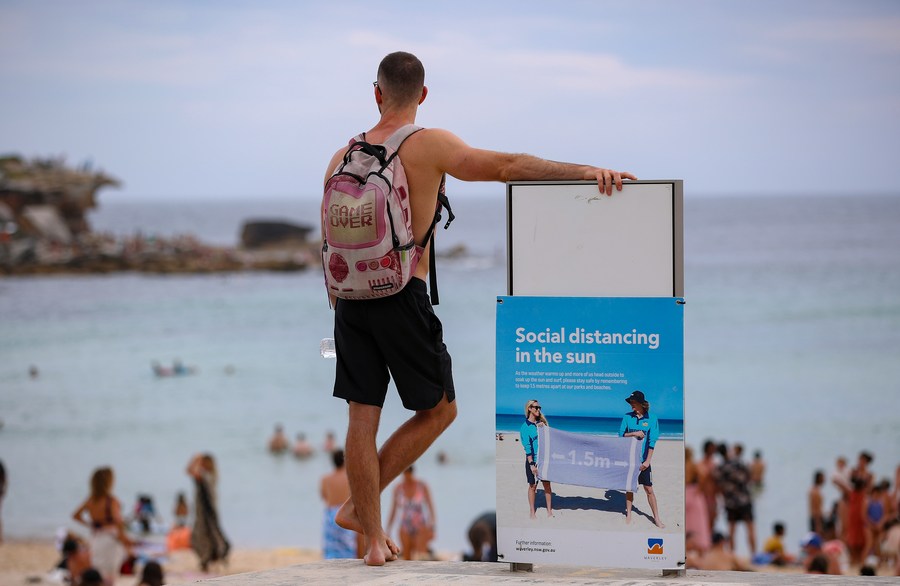
File photo taken on Jan. 26, 2021 shows a man standing beside a social distancing notice board at Bondi beach in Sydney, Australia. (Xinhua/Bai Xuefei)
In contrast, Australians have not broken stride since they began the march to reopening the economy. People endured extended lockdowns this year before the country gradually reopened in November when 80 percent of the population had been vaccinated.
"We're not going back to lockdowns," Australian Prime Minister Scott Morrison said on Dec. 21. "We're not going back to shutting down peoples' lives."
Overseas students and skilled workers can now enter Australia for the first time since March 2020, subject to quarantine requirements.
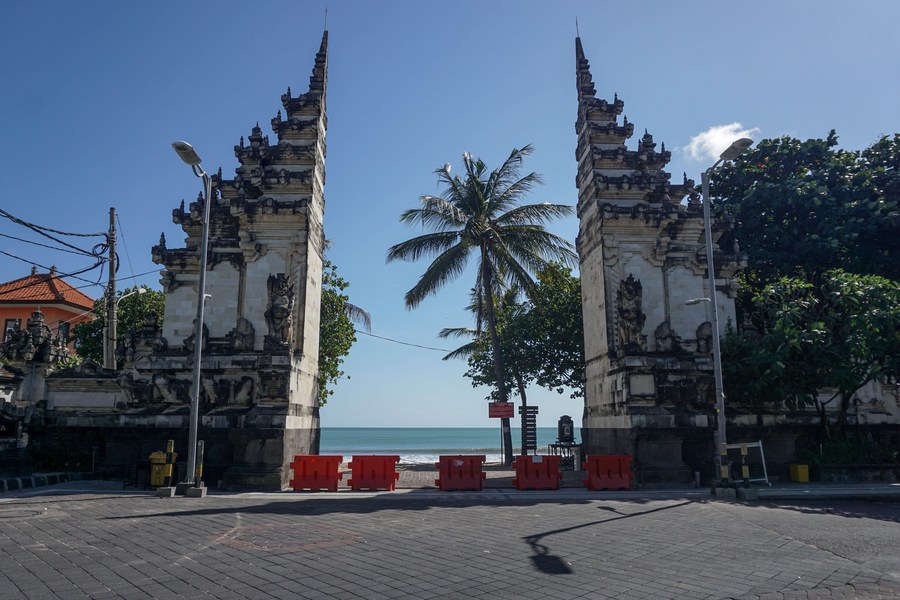
Road blocks are seen at the Sanur beach tourism site as part of local COVID-19 restriction measures in Denpasar, Bali, Indonesia, July 3, 2021. (Photo by Bisinglasi/Xinhua)
Many Asian countries have faced a long wait for the return of visitors. Tourism brings a huge amount of money into the economies of the Philippines, Sri Lanka and Thailand. Millions of jobs depend on a steady flow of foreign guests, a flow that has dried to a trickle during the pandemic.
Indonesia, Southeast Asia's biggest economy, has reopened for international tourists with flights from 19 countries allowed to travel to its world-renown holiday island of Bali since mid-October.
Foreign tourists, however, are still hesitant to visit Bali due to a lack of direct flights, extended quarantine and other uncertainties posed by Omicron.

A citizen receives the COVID-19 vaccine in Samut Prakan, Thailand, on Aug. 9, 2021. (Photo by Rachen Sageamsak/Xinhua)
DRIVING FORCE
Most of the Asia-Pacific region began vaccination drives early in the year. Many people are double-vaccinated and booster shots are becoming widely available.
Some poorer countries found themselves short of vaccines as richer countries hoarded supplies.
China calls for the rejection of vaccine nationalism and is committed to making vaccines a "global public good" and improving accessibility and affordability in developing countries.
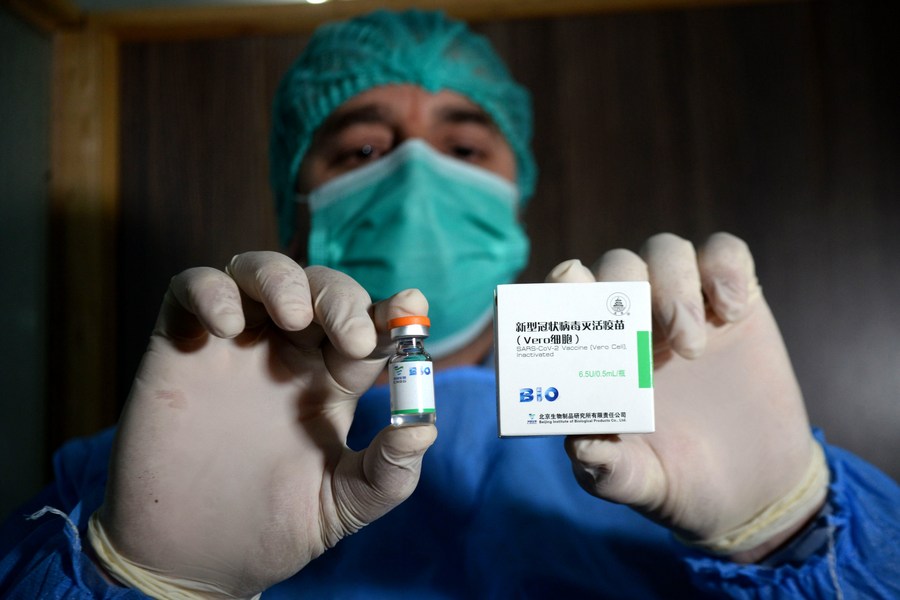
A medical worker shows China's COVID-19 vaccine at a hospital in Peshawar, Pakistan, Feb. 3, 2021. (Photo by Umar Qayyum/Xinhua)
Besides donations of personal protective equipment (PPE) and expert support, China has put its weight behind vaccination drives wherever possible.
China has helped many developing countries in Asia-Pacific in their vaccination drives through donations, bilateral procurements and technology transfer which enabled some of them, including Malaysia and Pakistan, to roll out locally packed Chinese vaccines.
Pakistan started its vaccination drive at the beginning of February with China-donated vaccines which had arrived just one day before. It was also the China-donated vaccines that helped the Philippines kick-start a national vaccination on March 1.
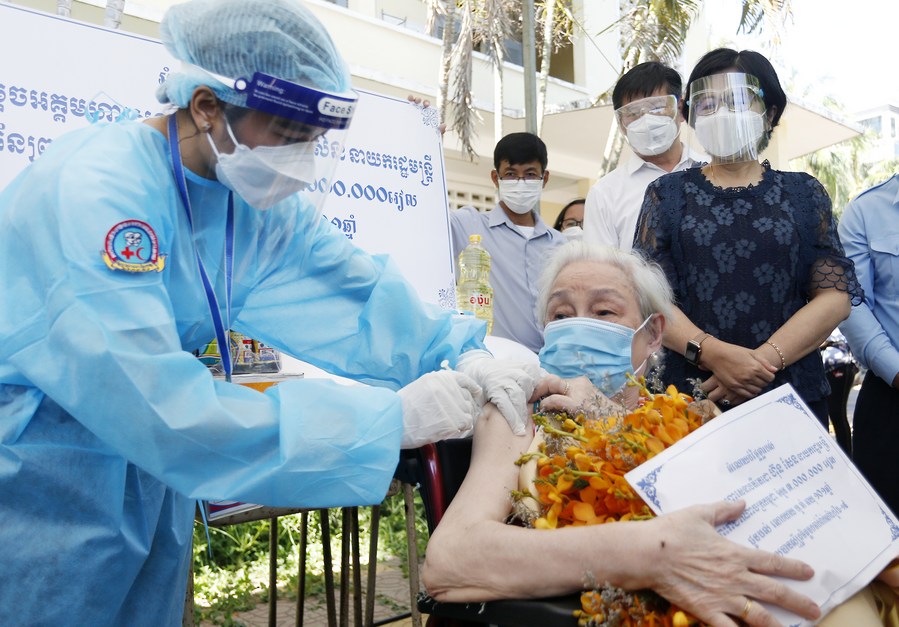
Ho Kham, a 101-year-old Cambodian woman, receives her second dose of Sinovac COVID-19 vaccine at an inoculation site in Phnom Penh, Cambodia on July 2, 2021. (Photo by Phearum/Xinhua)
In addition, Chinese vaccines have been largely behind Cambodia's astonishingly effective campaign. So far, more than 85 percent of Cambodia's 16 million people have been fully vaccinated.
Far from being a wealthy nation, Cambodia now enjoys one of the highest vaccination rates in the world, thanks to which, the country's daily COVID-19 cases fell to a single digit for the first time on Dec. 15, the lowest since February.
"China's vaccine supply to Cambodia and other countries is a testament to China's commitment to promoting COVID-19 vaccines as the global public goods and to campaigns against COVID-19," Cambodian Prime Minister Samdech Techo Hun Sen said in November.
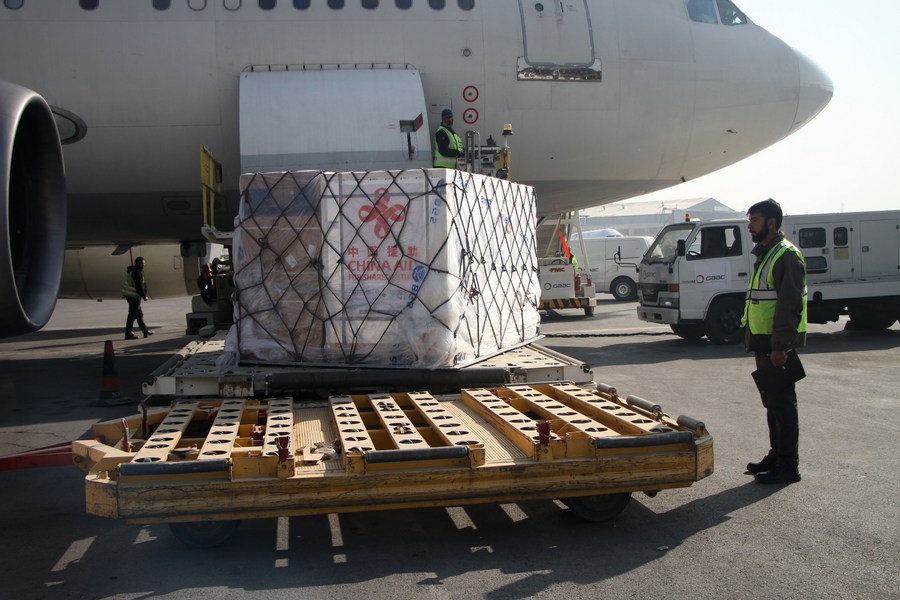
Staff members unload COVID-19 vaccines and syringes donated by the Chinese government at Kabul international airport in Kabul, capital of Afghanistan, Dec. 8, 2021. (Photo by Saifurahman Safi/Xinhua)
Afghanistan has problems aplenty to deal with, but the pandemic cannot just be ignored. A batch of supplies from China was handed over to Afghanistan in June.
Since then, the political situation in Afghanistan may have changed, but China has never stopped lending a helping hand, announcing to donate 3 million doses of vaccines and other medical supplies to Afghanistan. A new batch of doses arrived in Kabul on Dec. 8.
When India faced a critical situation in April and May, with hospitals overwhelmed, China provided India with tons of medicine, thousands of ventilators and oxygen generators, along with millions of face masks.
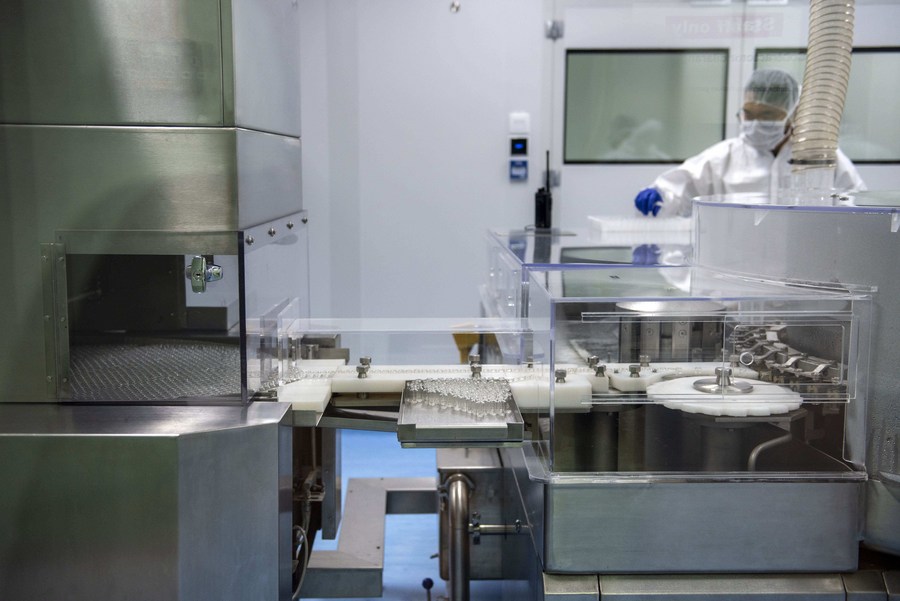
A technician operates during a test run of the "fill and finish" process for CanSino vaccine at Solution Biologics factory in Kuala Lumpur, Malaysia, Sept. 8, 2021. (Photo by Chong Voon Chung/Xinhua)
MULTILATERALISM ESSENTIAL
It seems unlikely that Omicron will be the last variant, and COVID-19 will certainly not be the last public health crisis the world faces.
China has been calling for the unity of the world with a vision of a global community of health for all, based on solidarity and cooperation.
In April, when a new wave of the pandemic broke out in South Asia, foreign ministers from Afghanistan, Bangladesh, China, Nepal, Pakistan and Sri Lanka met online to deepen cooperation.

Cambodia on Dec. 13, 2021 receives another batch of Chinese-made Sinovac COVID-19 vaccine through the COVAX Facility. (Photo by Sovannara/Xinhua)
Pakistan and Bangladesh in August received their first batches of COVID-19 vaccine that China provided for the COVAX, the WHO-led initiative for equitable distribution of COVID-19 vaccines around the world. As of Nov. 12, China has supplied more than 70 million vaccine doses to COVAX.
China has pledged to donate 100 million vaccine doses to other developing countries, in addition to donations worth 100 million U.S. dollars to the COVAX Facility.
Regionally, China and ASEAN have determinedly supported each other by providing vaccines, medical supplies and sharing experiences.
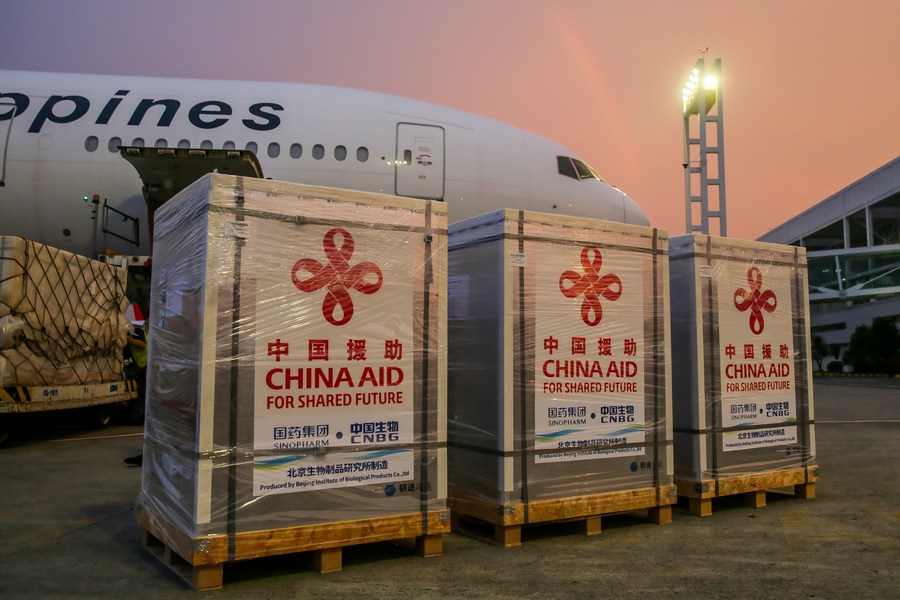
Cargos containing the Sinopharm COVID-19 vaccines are seen upon arrival in Manila, the Philippines, Aug. 20, 2021. (Xinhua/Rouelle Umali)
At the special summit to commemorate the 30th anniversary of China-ASEAN dialogue relations about a month ago, China spoke of the need for a "health shield" for the region.
In addition to more than 300 million doses of COVID-19 vaccine that China has provided to ASEAN countries, China is ready to donate 150 million more doses to ASEAN member states, contribute an additional sum of 5 million U.S. dollars to the COVID-19 ASEAN Response Fund, and step up joint vaccine production and technology transfers.
"ASEAN as a whole is looking keenly towards China for its own economic revitalization," Malaysian political analyst Azmi Hassan said.
Key to China's plans is providing other countries with the skills and technology to produce their own vaccines.
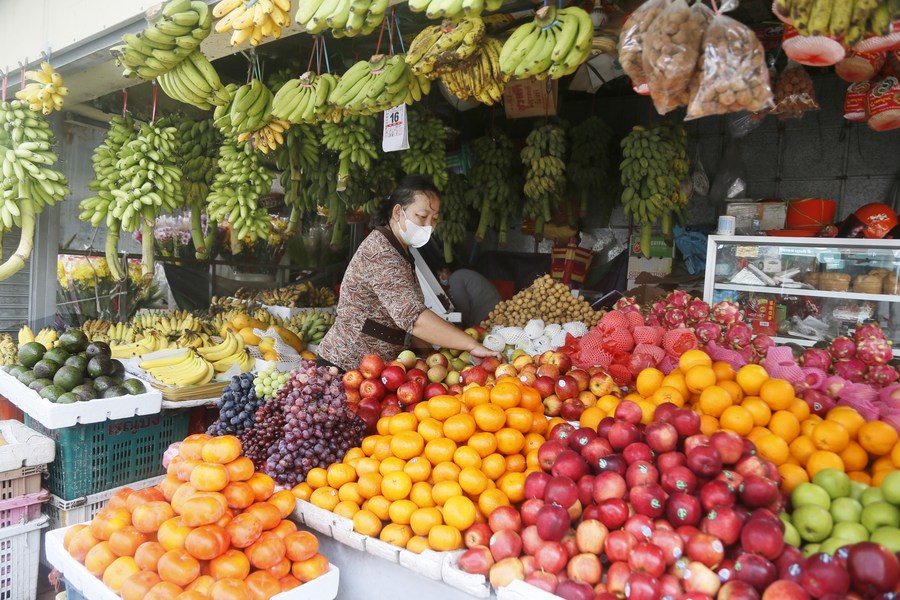
A vendor prepares fruits at a market in Phnom Penh, Cambodia, Nov. 17, 2021. (Photo by Phearum/Xinhua)
Late in November, a virtual Asia-Europe summit saw leaders of Asian and European countries affirm their universal commitment to research and development, technology transfer, and manufacturing and distribution of COVID-19 vaccines as well as other relevant medical supplies.
"Beyond the Asia and Europe continents, China has played a crucial role in the establishment of a new multi-polar world, in promoting multilateralism and win-win cooperation for inclusive and sustainable growth and development, and in the fight against COVID-19," Kin Phea, director-general of the International Relations Institute at the Royal Academy of Cambodia, told Xinhua recently.■

